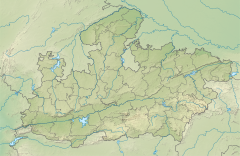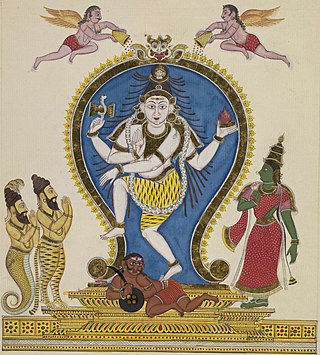
Nataraja, also known as Adalvallan, is a depiction of Shiva, one of the main deities in Hinduism, as the divine cosmic dancer. His dance is called the tandava. The pose and artwork are described in many Hindu texts such as the Tevaram and Thiruvasagam in Tamil and the Amshumadagama and Uttarakamika agama in Sanskrit and the Grantha texts. The dance murti featured in all major Hindu temples of Shaivism, and is a well-known sculptural symbol in India and popularly used as a symbol of Indian culture, as one of the finest illustrations of Hindu art. This form is also referred to as Kuththan, Sabesan, and Ambalavanan in various Tamil texts.

Pashupati is a Hindu deity and an incarnation of Shiva as the "Lord of the animals". Pashupati is mainly worshipped in Nepal and India. Pashupati is also the national deity of Nepal.

The Elephanta Caves are a collection of cave temples predominantly dedicated to the Hindu god Shiva, which have been designated a UNESCO World Heritage Site. They are on Elephanta Island, or Gharapuri, in Mumbai Harbour, 10 kilometres (6.2 mi) east of Mumbai in the Indian state of Mahārāshtra. The island, about 2 kilometres (1.2 mi) west of the Jawaharlal Nehru Port, consists of five Hindu caves, a few Buddhist stupa mounds that date back to the 2nd century BCE, and two Buddhist caves with water tanks.

Pattadakal, also called Raktapura, is a complex of 7th and 8th century CE Hindu and Jain temples in northern Karnataka, India. Located on the west bank of the Malaprabha River in Bagalkot district, this UNESCO World Heritage Site is 23 kilometres (14 mi) from Badami and about 9.7 kilometres (6 mi) from Aihole, both of which are historically significant centres of Chalukya monuments. The monument is a protected site under Indian law and is managed by the Archaeological Survey of India (ASI).

Mandsaur is a city and a municipality in Mandsaur district located on the border of Mewar and Malwa regions of Madhya Pradesh, a state in Central India. It is the administrative headquarters of Mandsaur District. The ancient Pashupatinath Temple is located in Mandsaur.

The Udayagiri Caves are twenty rock-cut caves near Vidisha, Madhya Pradesh primarily denoted to the Hindu gods Vishnu and Shiva from the early years of the 3rd century CE to 5th century CE. They contain some of the oldest surviving Hindu temples and iconography in India. They are the only site that can be verifiably associated with a Gupta period monarch from its inscriptions. One of India's most important archaeological sites, the Udayagiri hills and its caves are protected monuments managed by the Archaeological Survey of India.
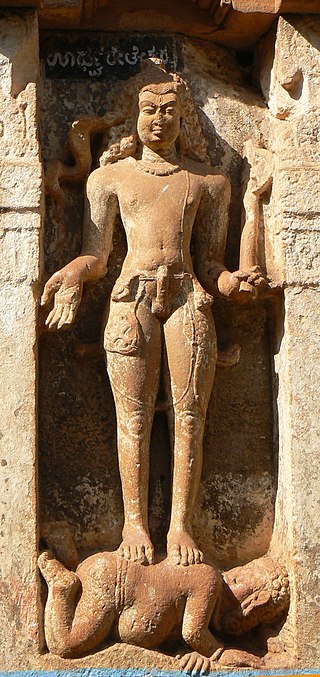
Lakulisha was a prominent Shaivite revivalist, reformist and preceptor of the doctrine of the Pashupatas, one of the oldest sects of Shaivism.
Jageshwar is a Hindu pilgrimage town near Almora in Almora district of the Himalayan Indian state of Uttarakhand. It is one of the Dhams in the Shaivism tradition. The site is protected under Indian laws, and managed by the Archaeological Survey of India (ASI). It includes Dandeshwar Temple, Chandi-ka-Temple, Jageshwar Temple, Kuber Temple, Mritunjaya Temple, Nanda Devi or Nau Durga, Nava-grah temple, a Pyramidal shrine, and Surya Temple. The site celebrates the Jageshwar Monsoon Festival during the Hindu calendar month of Shravan and the annual Maha Shivratri Mela, which takes place in early spring.

The Gudimallam Lingam is an ancient linga in the Parasurameswara Swamy Temple of Gudimallam, a small village near Tirupati city in the Yerpedu mandal of the Tirupati district of Andhra Pradesh, India. It is situated about 13 kilometers south-east of Tirupati city.

The Kasivisvesvara temple, also referred to as the Kavatalesvara, Kashivishveshvara or Kashi Vishvanatha temple of Lakkundi is located in the Gadag district of Karnataka state, India. It is about 12 kilometres (7.5 mi) from Gadag city, between Hampi and Goa. The Kasivisvesvara temple is one of the best illustrations of fully developed Kalyana Chalukya style of Hindu architecture.

Bhitargaon is a town, near city of Kanpur in Kanpur Nagar district, Uttar Pradesh, India, known for its ancient Hindu temple, the largest Indian brick temple to survive from the time of the Gupta Empire. Despite being heavily restored, a number of original features remain. It is dated to the late 5th century.
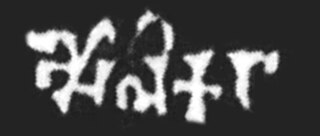
The Aulikara dynasty, was an ancient dynasty that ruled the Kingdom of Malwa between the 4th-century CE and 6th-century CE. They were based in the Malwa (Malava) region of central India near Mandsaur, with their power center near what is now western Madhya Pradesh, southeastern Rajasthan and northeastern Gujarat. Two royal houses belonging to this clan ruled over the present-day western Malwa region of Madhya Pradesh state from c. 350 CE to 550 CE, much of it as feudatories of the Gupta Empire.
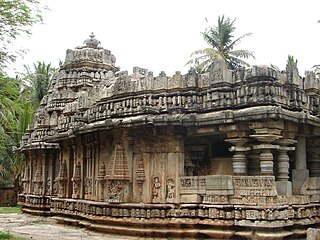
The Brahmeshvara temple, also referred to as the Brahmeshwara or Brahmesvara temple, is a 12th-century Hindu temple with Hoysala architecture in Kikkeri village, Mandya district of Karnataka state, India. Along with two other major historic temples within the village, the Brahmeshvara temple is one of many major ruined temples with notable artwork in Kikkeri area close to the more famous monuments of Shravanabelagola.

Alampuram Navabrahma Temples are a group of nine early Badami Chalukyan Hindu temples dated between the 7th and 9th centuries that are located at Alampuram (Hemalapuram) in Telangana, India, near the meeting point of Tungabhadra River and Krishna River at the border of Andhra Pradesh. They are called Nava-Brahma temples though they are dedicated to Shiva. They exemplify early North Indian Nagara style architecture with cut rock as the building block. The temples of Alampur resemble the style of Pattadakal, Aihole style as they were Karnata Dravida, Vesara style native to Karnataka.

Chaya Someswara Temple, also known as Chaya Someshvara Swamy Alayam or the Saila-Somesvara temple, is a Saivite Hindu temple located in Panagal, Nalgonda district of Telangana, India. It was built around the mid 11th-century during the rule of the Kunduru Chodas, supported and embellished further by later Hindu dynasties of Telangana. Some date it to late 11th to early 12th-century.

The Masrur Temples, also referred to as Masroor Temples or Rock-cut Temples at Masrur, is an early 8th-century complex of rock-cut Hindu temples in the Kangra Valley of Beas River in Himachal Pradesh, India. The temples face northeast, towards the Dhauladhar range of the Himalayas. They are a version of North Indian Nagara architecture style, dedicated to Shiva, Vishnu, Devi and Saura traditions of Hinduism, with its surviving iconography likely inspired by a henotheistic framework.
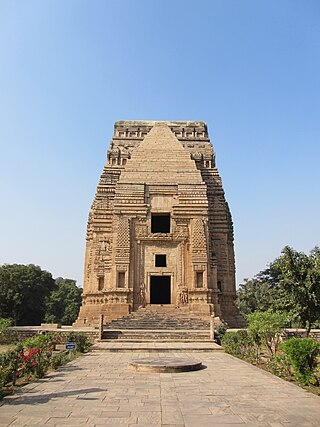
Teli ka Mandir, also known as Telika Temple, is a Hindu temple located within the Gwalior Fort in Madhya Pradesh, India. Dedicated to Shiva, Vishnu and Matrikas, it has been variously dated between the early 8th and early 9th century CE.

Nachna Hindu temples, also referred to as Nachana temples or Hindu temples at Nachna-Kuthara, in Panna district, Madhya Pradesh, India are some of the earliest surviving stone temples in central India along with those at Bhumara and Deogarh. Their dating is uncertain, but comparing their style to structures that can be dated, some of the Nachna temples are variously dated to the 5th- or 6th-century Gupta Empire era. The Chaturmukha temple is dated to the 9th century. These temples illustrate a North Indian style of Hindu temple architecture.

Bhumara Temple, sometimes called Bhumra, Bhubhara or Bharkuleswar, is a 5th or 6th-century Gupta era Hindu stone temple site dedicated to Shiva near Satna, in the Indian state Madhya Pradesh. The temple has a square plan with a sanctum and Mandapa. While much of it is in ruins, enough of the temple structure and works of art have survived for scholarly studies. The temple is notable as one of the early examples of an architecture that included an enclosed concentric pradakshina-patha. Like other early Gupta era Hindu temples, it includes a decorated entrance to the sanctum flanked by Ganga and Yamuna goddesses, and intricately carved sculptures.

Gupta art is the art of the Gupta Empire, which ruled most of northern India, with its peak between about 300 and 480 CE, surviving in much reduced form until c. 550. The Gupta period is generally regarded as a classic peak and golden age of North Indian art for all the major religious groups. Gupta art is characterized by its "Classical decorum", in contrast to the subsequent Indian medieval art, which "subordinated the figure to the larger religious purpose".


